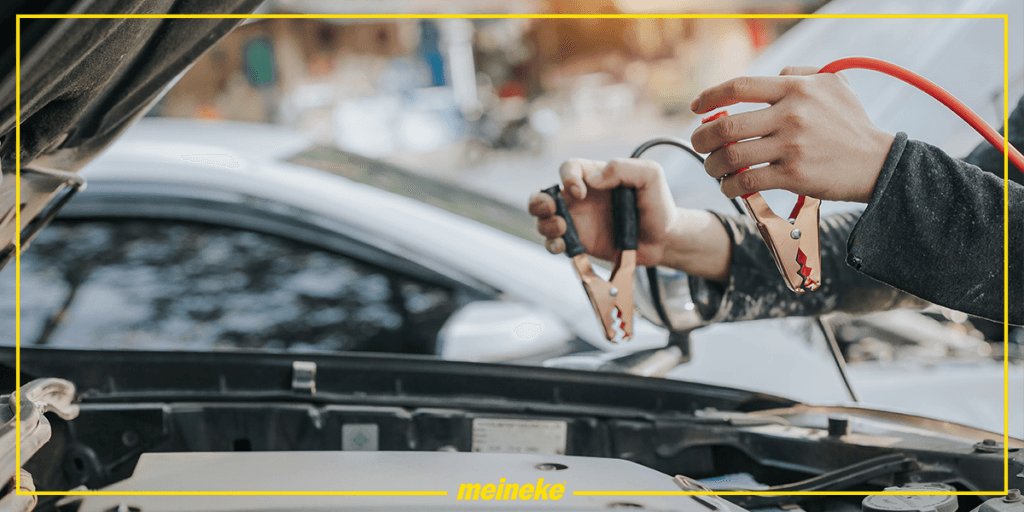
August 7, 2021
How to Jump a Car in 7 Steps
Learning how to jump a car can be useful for the days when you’re out running errands and your vehicle won’t start.
Charging a dead car battery may seem simple, but it involves more than just connecting a charger. Learn how to safely jumpstart your car from our certified automotive technician at Meineke.
Keep reading to learn how to jump a car, so you can get your car back on the road or safely to the repair shop.
Jumping a Car Using the 7-Step Process
Before you begin, you’ll need a set of jumper cables. Note that most cables have a power range from one to 12; the lower the number, the more power the cables can handle. For smaller vehicles, stick with ones with higher numbers. Once you have cables, here is how to jump-start a car.
1. Locate the Battery and Turn Off All Accessories
Some batteries are easily accessible, while others are under or in the fender. Some may even be in the trunk or under the seat, depending on the make and model of your vehicle.
Turn off all accessories, including the interior light. If you have anything on, it could cause the battery to arc while you are working with it.
2. Move the Two Vehicles Close to Each Other, but Don’t Let Them Touch
The car with the working battery should face the one with the dead battery. Keep them apart. Make sure the cars are spaced far enough apart so they don’t touch–about 18 inches is a good distance. Don’t forget to use the parking brakes on both cars so they remain completely still. Finally, make sure both vehicles are off.
3. Locate the Battery Terminals and Attach Your Cables
The black cable will have a negative (-) sign, and the red or positive cable will have a plus (+) sign. Don’t move forward in the jump process if your battery terminals are dirty. Use a toothbrush, a cloth, or a brush to minimize corrosive debris since they can cause your battery to malfunction.
Here is the correct order for installing jumping car cables:
First: Red (Positive) (+)
1. Attach the red cable to the dead battery–Secure the positive cable clamp onto the dead battery’s positive terminal.
2. Attach the red cable to the other car’s battery–Using that same cable, secure the opposite end of the red cable clamp to the positive terminal on the vehicle with the operating battery.
Then: Black (Negative) (-)
3. Attach the black cable to the working vehicle–Attach the negative cable clamp to the negative terminal of the car with the good battery.
4. Avoid attaching the negative cable clamp to the malfunctioning battery.
5. Secure the negative clamp onto a metal part of the car–Make sure the metal part you choose is free of paint.
4. Start the Vehicle with the Working Battery
Once you’ve attached the cables, turn on the vehicle with the good battery and wait. Remember, it may take a few minutes before the jump process shows signs of success.
5. Attempt to Start the Vehicle with the Dead Battery
Next, try to start the car with the dead battery. How long should it take to jump a car? Expect anywhere from 10 to 15 minutes before your vehicle is up and running.
6. Disconnect the Negative Jumper Cables, Followed by the Positive Cables
Start with the negative clamps, then remove the positive clamps. Remember that the clamps should never make any contact while connected to the cars. If they touch, this can cause a spark.
7. Drive the Jumped Car
Drive your car around for 30 minutes to help the battery increase its charge. This way, your car will operate like it should without the battery malfunctioning again.
What If the Jump-Start Fails?
While jumping a car is a simple procedure, it isn’t always easy, especially when you’re doing everything right and the car still won’t start. If your battery won’t hold a charge, you should:
- Allow the battery to recharge longer by keeping the cables connected.
- Look for any signs of corrosion on the terminals.
- Check the starter motor by looking for signs of damage.
The reason for a failed charge is difficult to pinpoint and can indicate an issue with:
- Fuses
- Faulty alternator
- Ignition switch
- Starter connection
- Dead battery
That last bullet point is critical. If all the other components are functioning, and your battery still won’t charge, it could be a sign your battery has reached the end of its lifespan. At that point, continuing to try to charge a dead battery would be a wasted effort. The best solution if this happens is to take your car to an auto shop.
Get Your Vehicle Running at Meineke
Got a dead battery that won’t charge? The experienced mechanics at Meineke can install a new one and have you back on the road in no time.
Find a service location near you to get started.



